Digital Signage: Driving business at dealerships
by all | 5 January 2013 8:30 am
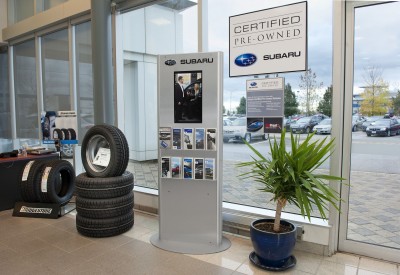 [1]
[1]Photos courtesy Subaru Canada
By Peter Saunders
In 2011, Subaru Canada, based in Mississauga, Ont., announced the introduction of ‘Subaru.TV,’ a new stream of digital signage content developed to help connect the company’s brand identity with customers’ shopping experiences at its 86 authorized dealerships by explaining various products and services. The project’s goal was to ensure Subaru could engage and entertain its customers directly, rather than allow them to be distracted by random content airing on regular TVs that had been installed in some dealerships in the past.
“The argument was simple,” says George Hamin, director of e-business and information systems. “Every day, we and our dealer network collectively spent thousands of dollars to drive prospective buyers and returning customers into our dealership. Once there, they were greeted with outdated promotional materials and, in some cases, TVs showing competitor advertising.”
While many individual dealerships or dealer groups had some form of customer-facing digital signage in place at the time, Subaru sought to become Canada’s first automotive original equipment manufacturer (OEM) to deploy the technology at a national level. To this end, it had spent the previous year sourcing and developing enough high-definition (HD) content to make the experience distinctive.
Though it was inspired by digital signage networks in restaurants like Tim Hortons and Lick’s, Subaru did not want menu-style boards cycling through advertising, specials and promotions. Rather, the content was meant to seem like TV, just without competitors’ ads.
Finding partners
After partnering with Vancouver-based digital signage integrator 10net Managed Solutions, Subaru began gradually deploying a network of 1- and 1.3-m (42- and 52-in.) Sharp liquid crystal displays (LCDs) in May 2011, reaching across Canada. The network used a customized Dell media server running Scala’s Player software to provide unique content across both sales and after-sales service channels, available in English and French.
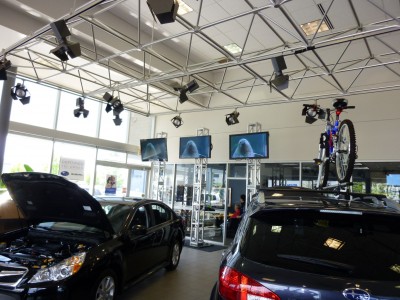 [2]
[2]The rollout of ‘Subaru.TV’ began in 2011, extending across Subaru Canada’s 86 authorized dealerships throughout the country.
In addition, dealers that were already running Calgary-based PBS Systems’ Aristo contact management software and its integrated media suite were able to display the current status of vehicles in their service bays, helping reduce the need for oil-change and repair customers to keep checking in at the service counters. Subaru announced it would also work with other vendors of this type of dealership software to offer similar content integration opportunities.
Some two-thirds of the network rollout was completed when Subaru.TV was officially launched in time for the screens to display a five-minute sneak preview of the 2012 Impreza compact car, which was scheduled for release in October 2011.
As mentioned, however, Subaru’s goal was for the content to come across like a private TV network. So, the company also entered early discussions to secure nationally syndicated news, sports reports and other third-party content.
Addressing challenges
When Subaru originally began planning the network in 2009, the main challenges were cost and flexibility. The dealers did not need the sleekest new technology, but rather an open system that would not tie them to any particular partner forever. This was important in terms of customizing content in an open development environment, including applications for the aforementioned service status integration, Rich Site Summary (RSS) news feeds and previously owned vehicle inventories.
Most vendors proposed their own self-developed software-as-a-service (SaaS) offerings in ways that would tie Subaru to them indefinitely, with significant costs associated with any new feature requests.
“We spent more than two years looking at various options,” says Hamin. “Having already brought our website development in-house, we wanted to maintain that freedom.”
With its project management perspective, however, 10net proposed the Scala software—because it would be a flexible platform for various screen formats, including landscape and portrait modes and both split-screen and full-screen formatting—and a server that could process multiple HD streams with no restrictions, for a true broadcast feel with no jitter. Subaru could buy and own its software licences and then use Scala’s scripting language to develop new functionality independently, as required.
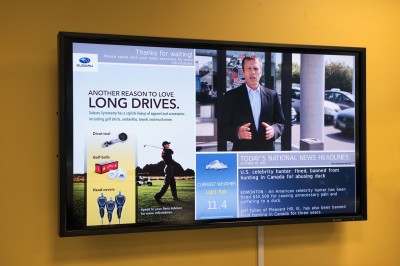 [3]
[3]Unique content is provided through both sales and after-sales service channels, in English and French.
Further, 10net suggested several cost-cutting measures, including specifying a single computer to handle the multiple streams, with Category 5 (Cat 5) twisted-pair cable for video distribution. This way, there would be no need for individual computers to be installed at each display location. Another initiative involved multiplexing two channels of audio using a single 5.1 surround-sound multi-channel audio card, which would reduce costs for analogue-to-digital (A-D) converters and other hardware.
Central management was essential in making the network as ‘hands-free’ as possible for the dealers themselves. 10net would host the network and push out content to the dealers, with the option down the road for Subaru to move all of the software, playlists and other resources to its own data centre, should circumstances governing their relationship ever change.
Specifying screens
Once this network management scenario was worked out, Subaru’s senior executives and dealers all came on board enthusiastically. They had seen customer-facing digital signage elsewhere and understood its value. Indeed, as mentioned, some dealers were already using their own digital signs.
One of the next steps was to choose the screens themselves. This decision was left until relatively late in the planning process because LCD technology had continued to evolve and drop in price.
Three options were installed in a corporate-owned dealership and evaluated throughout a full day of use. Two out of the three were then taken to an annual dealer meeting for further thoughts before making a final decision.
It proved easier to install the LCDs at new and renovated dealerships, as the walls needed to be reinforced and power cabling had to be run to the display locations. These alterations were also subject to different building and electrical codes in different provinces, so the process took some time.
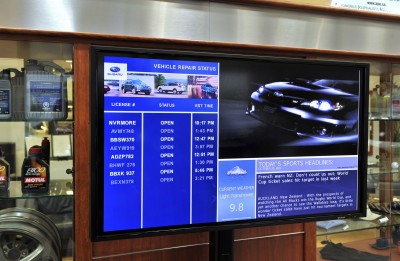 [4]
[4]An open system was required, so Subaru could integrate current vehicle service status information gleaned from its dealers’ existing contact management software.
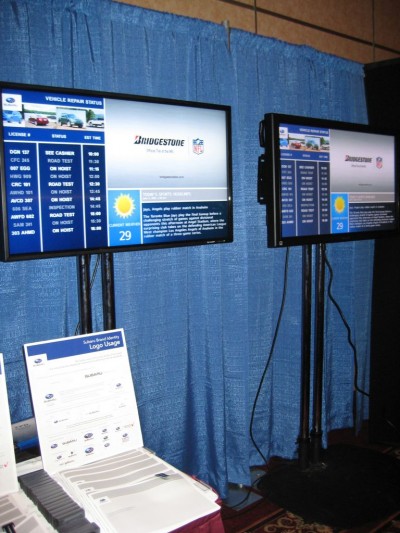 [5]
[5]Creating content
Today, Subaru’s own development team creates the content in-house, some of which is also recompressed for simultaneous use on the company’s website (www.subaru.ca[6]) and YouTube channel (www.youtube.com/subarucanada[7]) and ‘amplified’ through tweets on Twitter and wall posts on Facebook. Ads often debut on the digital signage network before airing on TV.
Shooting, editing and grading a video is relatively inexpensive, not only because the internal studio handles scripting and storyboarding, but also because it can turn to archives of broadcast-quality footage. Most stand-alone facilities cannot access such resources for digital signage.
“We realized we could produce high-quality HD content for less money than had been spent printing single-use point-of-purchase (POP) materials that were obsolete the moment they came off the press,” says Hamin. “Digital signage is here to stay.”
As per 10net’s promise, the team has also been able to add new functionality, including the service status integration and previously owned vehicle inventories, which repurpose photos and data sourced from www.subaru.ca[6]. One of the next steps will be to allow dealers to upload their own static ad content. Currently, Subaru maintains this localized content at the corporate level on the dealers’ behalf.
Raising revenue
Benefiting from a shift in Subaru’s marketing spending away from POP materials, brochures and newspaper ads, the digital signage network is now considered a self-funding system. To raise more revenue to buy syndicated content, however, the company began looking into using Scala’s Ad Manager software.
“There has been some disagreement over whether or not we should show syndicated content and sell ads to pay for it,” says Hamin, “so we are going to run it by our dealers to get their thoughts.”
Advantages would include gaining access to a vast amount of new content daily, which would keep the programming fresh, and the opportunity for highly targeted advertising to improve Subaru’s brand position, particularly ads for third-party products the company resells, such as tires and roof racks.
“We will see,” Hamin says.
With files from Subaru Canada and 10net Managed Solutions. For more information, visit www.subaru.ca[6] and www.10net.net[8].
- [Image]: http://www.signmedia.ca/wp-content/uploads/2014/02/Kiosk_SOMI_D110506.jpg
- [Image]: http://www.signmedia.ca/wp-content/uploads/2014/02/P1000421.jpg
- [Image]: http://www.signmedia.ca/wp-content/uploads/2014/02/StaticAd2_SOMI_D110414.jpg
- [Image]: http://www.signmedia.ca/wp-content/uploads/2014/02/Service_Status_SOMI_D110394.jpg
- [Image]: http://www.signmedia.ca/wp-content/uploads/2014/02/Service_Status_Board.jpg
- www.subaru.ca: http://www.subaru.ca
- (www.youtube.com/subarucanada: http://(www.youtube.com/subarucanada
- www.10net.net: http://www.10net.net
Source URL: https://www.signmedia.ca/driving-business-at-dealerships/